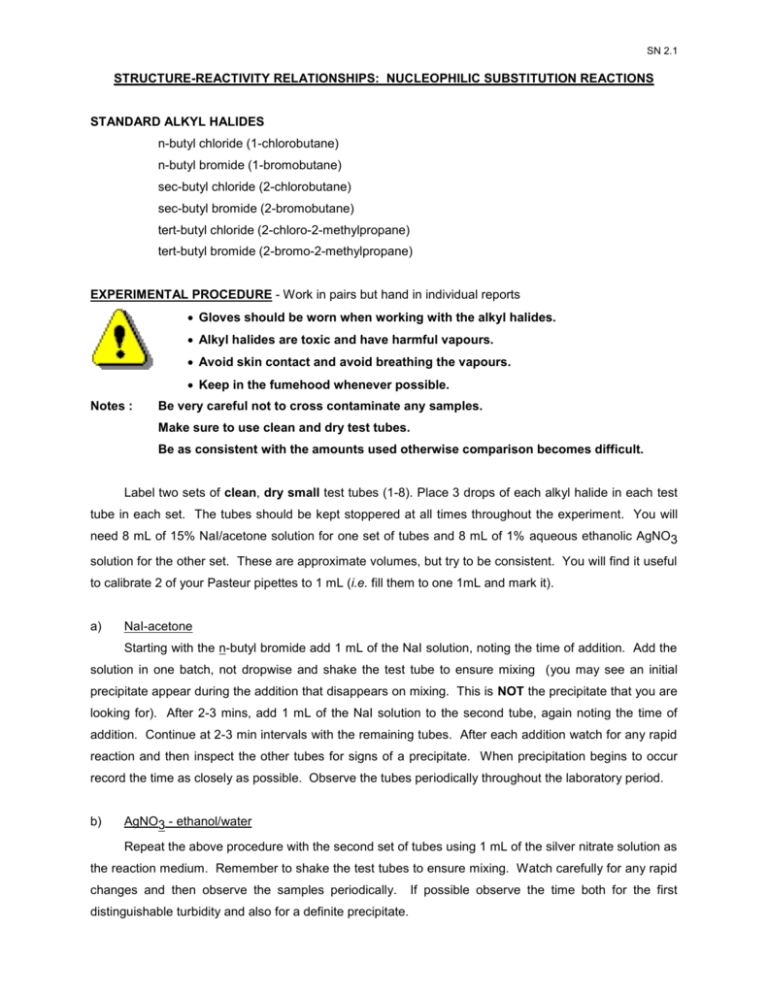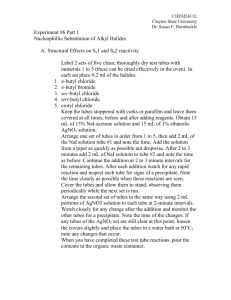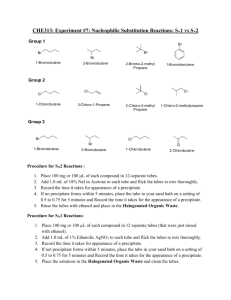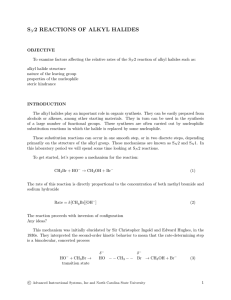Experimental procedure
advertisement

SN 2.1 STRUCTURE-REACTIVITY RELATIONSHIPS: NUCLEOPHILIC SUBSTITUTION REACTIONS STANDARD ALKYL HALIDES n-butyl chloride (1-chlorobutane) n-butyl bromide (1-bromobutane) sec-butyl chloride (2-chlorobutane) sec-butyl bromide (2-bromobutane) tert-butyl chloride (2-chloro-2-methylpropane) tert-butyl bromide (2-bromo-2-methylpropane) EXPERIMENTAL PROCEDURE - Work in pairs but hand in individual reports Gloves should be worn when working with the alkyl halides. Alkyl halides are toxic and have harmful vapours. Avoid skin contact and avoid breathing the vapours. Keep in the fumehood whenever possible. Notes : Be very careful not to cross contaminate any samples. Make sure to use clean and dry test tubes. Be as consistent with the amounts used otherwise comparison becomes difficult. Label two sets of clean, dry small test tubes (1-8). Place 3 drops of each alkyl halide in each test tube in each set. The tubes should be kept stoppered at all times throughout the experiment. You will need 8 mL of 15% NaI/acetone solution for one set of tubes and 8 mL of 1% aqueous ethanolic AgNO3 solution for the other set. These are approximate volumes, but try to be consistent. You will find it useful to calibrate 2 of your Pasteur pipettes to 1 mL (i.e. fill them to one 1mL and mark it). a) NaI-acetone Starting with the n-butyl bromide add 1 mL of the NaI solution, noting the time of addition. Add the solution in one batch, not dropwise and shake the test tube to ensure mixing (you may see an initial precipitate appear during the addition that disappears on mixing. This is NOT the precipitate that you are looking for). After 2-3 mins, add 1 mL of the NaI solution to the second tube, again noting the time of addition. Continue at 2-3 min intervals with the remaining tubes. After each addition watch for any rapid reaction and then inspect the other tubes for signs of a precipitate. When precipitation begins to occur record the time as closely as possible. Observe the tubes periodically throughout the laboratory period. b) AgNO3 - ethanol/water Repeat the above procedure with the second set of tubes using 1 mL of the silver nitrate solution as the reaction medium. Remember to shake the test tubes to ensure mixing. Watch carefully for any rapid changes and then observe the samples periodically. distinguishable turbidity and also for a definite precipitate. If possible observe the time both for the first If any tubes in the NaI-acetone series are still clear at this point, loosen the corks and place the tubes in a beaker of warm water and note any changes that subsequently occur. Ensure that you do not evaporate volatile contents or subsequent precipitation may result from concentration effects rather than reaction products. Make sure you collect the class data for both sets of reaction conditions from all students in your laboratory section, you will need to use it in your report. CLEAN UP Dispose of all solutions in the drum for organic waste in the fume-hood. REFERENCES 1a. th M. Jones and S.A. Fleming, in "Organic Chemistry", Norton, 4 edition, Chapter 7, pp.261-298 th M. Jones and S.A. Fleming, in "Organic Chemistry", Norton, 5 edition, Chapter 7 b. http://www.chem.ucalgary.ca/courses/351/Carey5th/Ch04/ch4-3.html http://www.chem.ucalgary.ca/courses/351/Carey5th/Ch08/ch8-0.html REPORT Before writing any Chem 351 laboratory report, we strongly recommend that you review section 8 in the introductory section of the student laboratory manual that discusses how to write reports and/or from “writing reports” on the course website. Students often don’t get the grades they would like because they make errors that are addressed in that section of the manual. These are avoidable errors. The report for this experiment uses the report template and this is due at the end of the laboratory period. You can start work on this before the laboratory period starts. You might want to bring your lecture notes or a text for reference. Remember that more it not necessarily better. It is important to be accurate and concise rather than verbose and vague. Proper English should be used and it should be written in your own words.








